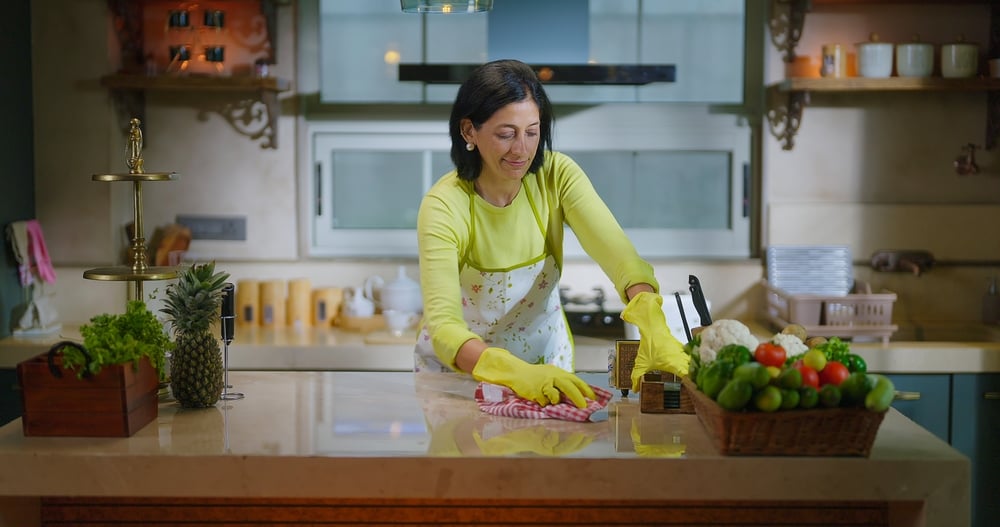Marriage isn’t what it used to be—and that’s not necessarily a bad thing.

For generations, marriage came with a rigid set of expectations. Boomer couples were told how to behave, who should do what, and what counted as a “successful” relationship. Many of those rules were based on outdated gender roles, societal pressure, or the idea that marriage should look the same for everyone. But times have changed, and younger generations are questioning whether those old guidelines still make sense.
Today’s couples are redefining what a healthy, happy marriage looks like. They’re rejecting the notion that staying together at all costs is the ultimate goal, or that love means sacrificing individuality. Relationships are evolving, and so are the rules that govern them. Here are eleven old-school marriage rules that modern couples are leaving in the past.
1. The husband should always be the primary breadwinner.

For decades, a man’s worth in marriage was tied to his ability to provide financially, while a woman’s role was centered around the home. This setup worked for many Boomer couples, but it also left women financially dependent and men carrying the weight of sole responsibility, according to Regina Bethincourt of Verily Mag. The idea that a successful marriage requires a man to earn more is quickly becoming outdated.
Modern couples are embracing financial flexibility. Dual-income households are the norm, and many women are out-earning their partners without it being seen as a problem. More men are also stepping into caregiving roles, proving that marriage isn’t about rigid job descriptions—it’s about teamwork and finding what works best for both partners.
2. Divorce is a last resort, no matter how unhappy you are.

Boomers were raised to believe that marriage was a lifelong commitment, no matter what. The idea of “sticking it out” was often prioritized over personal happiness, leading many couples to stay in toxic, loveless, or even harmful relationships just to avoid the stigma of divorce, according to The Knot.
Younger generations see things differently. While commitment is still valued, people now recognize that sometimes the healthiest choice is to walk away. Divorce is no longer seen as a failure but as a decision to prioritize well-being. Couples today are more willing to admit when a relationship isn’t working and take steps to build a happier, healthier life—whether together or apart.
3. Women should take their husband’s last name.

For decades, changing your last name after marriage wasn’t just expected—it was assumed. Women who kept their maiden names were often questioned or even judged for not fully “committing” to their new role as a wife. The tradition was rarely up for debate, and few considered the possibility of doing things differently, as reported by Brides.com.
Now, more women are keeping their names, hyphenating, or even having their husbands take their last name. Some couples create a brand-new last name together. The shift isn’t just about feminism; it’s about choice. A name doesn’t define a marriage, and younger generations are rejecting the idea that love requires sacrificing part of their identity.
4. The wife should handle all housework and childcare.

Boomer marriages largely followed the “man works, woman stays home” model, even when women had jobs. Housework and parenting were seen as the wife’s responsibility, regardless of how much she worked outside the home. Many women found themselves managing a household and a career with little help from their husbands.
That dynamic isn’t flying with modern couples. Chores and parenting duties are being split more evenly, and the idea that one partner should shoulder all the domestic labor is fading fast. Shared responsibility not only reduces stress but also strengthens relationships by making both partners feel valued.
5. A good wife should always keep the peace.

Many Boomer women were raised to believe that a successful marriage meant keeping their husband happy at all costs. That often meant swallowing their frustrations, avoiding difficult conversations, and prioritizing harmony over honesty. Expressing dissatisfaction was seen as nagging, and many women were expected to “pick their battles” rather than speak their minds.
Today’s marriages are built on open communication and emotional honesty. Partners are encouraged to express their needs, set boundaries, and work through conflicts together. Silence doesn’t equal strength, and younger generations understand that a healthy relationship allows both people to be heard.
6. Sleeping in separate beds means your marriage is failing.

For Boomers, sharing a bed was a non-negotiable part of marriage. Couples who slept separately were assumed to be unhappy or on the verge of divorce. The idea of needing personal space, different sleep schedules, or just preferring separate beds wasn’t taken seriously.
Now, couples are realizing that sleeping arrangements don’t define a relationship. Many partners sleep in different beds—or even separate rooms—because it improves their rest and overall happiness. Some people snore, others are light sleepers, and some just need their own space. Prioritizing good sleep over tradition doesn’t mean the marriage is falling apart—it means it’s built on mutual understanding.
7. Finances should be merged into a single account.

Older generations believed that marriage meant combining everything—including bank accounts. Having separate finances was often seen as a sign of distrust or a lack of unity. Couples were expected to pool their income and share every financial decision.
Younger couples are taking a more flexible approach. Many still combine finances, but plenty keep separate accounts or use a hybrid system. They recognize that financial independence can exist within a strong marriage and that different setups work for different relationships. Money doesn’t define commitment—respect and communication do.
8. Marriage is about sacrificing personal dreams for the relationship.

Boomer marriages often came with the unspoken rule that personal dreams should take a backseat to the partnership. One person—usually the wife—was expected to make career sacrifices, relocate for their spouse’s job, or put their own goals aside for the sake of the marriage.
Now, marriage is about supporting each other’s ambitions, not sacrificing them. Couples are finding ways to pursue their individual goals while still maintaining a strong relationship. A healthy marriage isn’t about giving up dreams—it’s about helping each other achieve them.
9. Men don’t need to be emotionally available.

Traditional Boomer masculinity discouraged men from being open about their feelings. Vulnerability was seen as weakness, and emotional conversations were often dismissed as unnecessary. Women were expected to handle the emotional labor in the marriage while men remained distant and stoic.
That dynamic is shifting. Emotional intimacy is now recognized as essential for a strong marriage. Modern couples understand that both partners should be able to express their feelings, seek support, and connect on a deeper level. Emotional unavailability isn’t strength—it’s a barrier to real connection.
10. Marriage is the ultimate life goal.

For Boomers, getting married was seen as a milestone that marked true adulthood. If you weren’t married by a certain age, people assumed something was wrong. The idea of choosing to stay single or delaying marriage for personal growth was almost unheard of.
Today, marriage is a choice, not an expectation. People are waiting longer, prioritizing their careers, or skipping marriage altogether. Happiness isn’t defined by a ring on your finger—it’s about creating a life that feels fulfilling, whether that includes marriage or not.
11. Staying together for the kids is always the right choice.

Boomers were often told that no matter how bad a marriage got, staying together for the children was the responsible thing to do. Divorce was seen as a failure that could damage kids for life, so many couples endured unhappy marriages just to maintain the appearance of stability.
Now, people recognize that kids are better off with happy, healthy parents—whether they’re together or not. Divorce, when handled with care, can lead to better environments for both children and parents. Staying in a toxic or joyless marriage isn’t noble; it’s damaging. A peaceful home matters more than an unbroken one.
